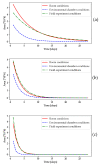A Lifetime of a Dispenser-Release Rates of Olive Fruit Fly-Associated Yeast Volatile Compounds and Their Influence on Olive Fruit Fly (Bactrocera oleae Rossi) Attraction
- PMID: 36985404
- PMCID: PMC10052186
- DOI: 10.3390/molecules28062431
A Lifetime of a Dispenser-Release Rates of Olive Fruit Fly-Associated Yeast Volatile Compounds and Their Influence on Olive Fruit Fly (Bactrocera oleae Rossi) Attraction
Abstract
The objective of this study was to evaluate the release rate, duration, and biological efficiency of yeast volatile compounds associated with olive fruit flies in slow-release dispensers, polypropylene vials, and rubber septa attached to yellow sticky traps under different environmental conditions in order to protect the environment, humans, and nontarget organisms. Isoamyl alcohol, 2-octanone, and 2-phenethyl acetate were placed in dispensers and tested over a four-week experiment. The weight loss of the volatile compounds in both dispensers was measured, and a rapid, inexpensive, and simple HS-GC/FID method was developed to determine the residual amount of volatiles in the septa. 2-Phenethyl acetate stood out in the rubber septa and showed a statistically significant difference in the release ratio compared to the other volatiles under all conditions tested. Our results showed that the attraction of olive fruit flies increased with decreasing concentrations of the tested volatiles. Regarding the number of flies attracted by rubber septa containing 2-phenethyl acetate, significantly better results were obtained than for septa containing isoamyl alcohol and 2-octanone, in contrast to the attraction of olive fruit flies to polypropylene vials containing these compounds but without significant difference. Since the presence of all tested chemicals was detected during the experiment, this opens the possibility of using more environmentally friendly and cost-effective dispensers with a significantly lower amount of semiochemicals.
Keywords: HS-GC/FID; olive; olive fruit fly; semiochemicals; slow-release dispensers; volatile release rate; yeast.
Conflict of interest statement
The authors declare no conflict of interest.
Figures







References
-
- Boller E.F. Biotehnical Methods for the Management of Fruit Fly Populations. In: Cavalloro R., editor. Fruit Flies of Economic Importance. A.A.Balkema; Rotterdam, The Netherlands: 1983. pp. 342–352.
-
- Bakthavatsalam N. Semiochemicals. In: Omkar I., editor. Ecofriendly Pest Management for Food Security. Academic Press; Lucknow, India: 2016. pp. 563–611.
-
- Ezzat S.M., Jeevanandam J., Egbuna C., Merghany R.M., Akram M., Daniyal M., Nisar J., Sharif A. Semiochemicals: A Green Approach to Pest and Disease Control. Elsevier Inc.; Amsterdam, The Netherlands: 2019.
-
- El-Ghany N.M.A. Semiochemicals for Controlling Insect Pests. J. Plant Prot. Res. 2019;59:1–11. doi: 10.24425/jppr.2019.126036_rfseq1. - DOI
-
- El-Shafie H.A.F., Faleiro J.R. Semiochemicals and Their Potential Use in Pest Management. In: Vonnie D.C.S., editor. Biological Control of Pest and Vector Insects. IntechOpen; Rijeka, Croatia: 2017. pp. 3–22.
MeSH terms
Substances
Grants and funding
LinkOut - more resources
Full Text Sources
Miscellaneous

